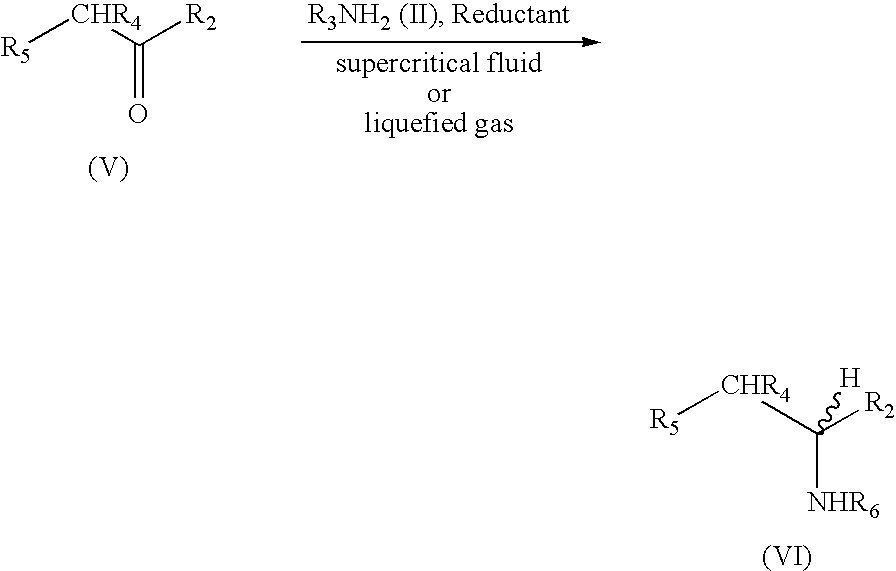Methods for the synthesis of amines such as ephedrine and intermediates
a technology of ephedrine and ephedrine, which is applied in the preparation of amino-hyroxy compounds, microorganisms, biochemistry apparatus and processes, etc., can solve the problems of poor yield, difficult synthesis, and difficult synthesis of ephedrine, so as to achieve optimum reaction time, reduce conversion, and reduce the effect of labor
- Summary
- Abstract
- Description
- Claims
- Application Information
AI Technical Summary
Benefits of technology
Problems solved by technology
Method used
Image
Examples
example 1
Reaction in Supercritical Carbon Dioxide Using Liquid Methylamine
[0063]Phenylacetylcarbinol (0.2 g, 1.3 mmol), palladium catalyst (0.05 g) and liquid methylamine (3 mls) were placed into a 250 ml stainless steel pressure vessel. The vessel was pressurised up to 400 psi with hydrogen gas and then up to a total of 1500 psi by pumping dried liquid carbon dioxide into the vessel. The vessel was then stirred in a 35° C. water bath for 24 h. After 24 h, the reaction vessel was cooled to room temperature and slowly de-gassed. The vessel contents and residue was washed three times with diethyl ether and filtered. Gas chromatography analysis revealed 78% conversion of phenylacetylcarbinol (PAC) to ephedrine.
example 2
Reaction in Supercritical Carbon Dioxide Using Methylamine in THF
[0064]Phenylacetylcarbinol (0.2 g, 1.3 mmol), palladium catalyst (0.05 g) and 5 fold excess of 2.0M methylamine in THF (3.125 mls, 6.45 mmol) were placed into a 250 ml stainless steel pressure vessel. The vessel was pressurised up to 400 psi with hydrogen gas and then up to a total of 1500 psi by pumping dried liquid carbon dioxide into the vessel. The vessel was then stirred in a 35° C. water bath for 24 h. After 24 h, the reaction vessel was cooled to room temperature and slowly de-gassed. The vessel contents and residue was washed three times with diethyl ether and filtered. Gas chromatography analysis revealed 46% conversion of phenylacetylcarbinol (PAC) to ephedrine.
example 3
Reaction in Supercritical Carbon Dioxide Using Gaseous Methylamine
[0065]Phenylacetylcarbinol (0.2 g, 1.3 mmol), palladium catalyst (0.05 g) were placed into a 250 ml stainless steel pressure vessel. Anhydrous gaseous methylamine was vented into the vessel to a pressure of approximately 100 psi. The vessel was then pressurised up to 400 psi with hydrogen gas and up to a final pressure of 1500 psi by pumping dried liquid carbon dioxide into the vessel. The vessel was then stirred in a 35° C. water bath for 24 h. After 24 h, the reaction vessel was cooled to room temperature and slowly de-gassed. The vessel contents and residue was washed three times with diethyl ether and filtered. Gas chromatography analysis revealed 32% conversion of phenylacetylcarbinol (PAC) to ephedrine.
PUM
| Property | Measurement | Unit |
|---|---|---|
| reaction temperature | aaaaa | aaaaa |
| reaction temperature | aaaaa | aaaaa |
| pressure | aaaaa | aaaaa |
Abstract
Description
Claims
Application Information
 Login to View More
Login to View More - R&D
- Intellectual Property
- Life Sciences
- Materials
- Tech Scout
- Unparalleled Data Quality
- Higher Quality Content
- 60% Fewer Hallucinations
Browse by: Latest US Patents, China's latest patents, Technical Efficacy Thesaurus, Application Domain, Technology Topic, Popular Technical Reports.
© 2025 PatSnap. All rights reserved.Legal|Privacy policy|Modern Slavery Act Transparency Statement|Sitemap|About US| Contact US: help@patsnap.com



